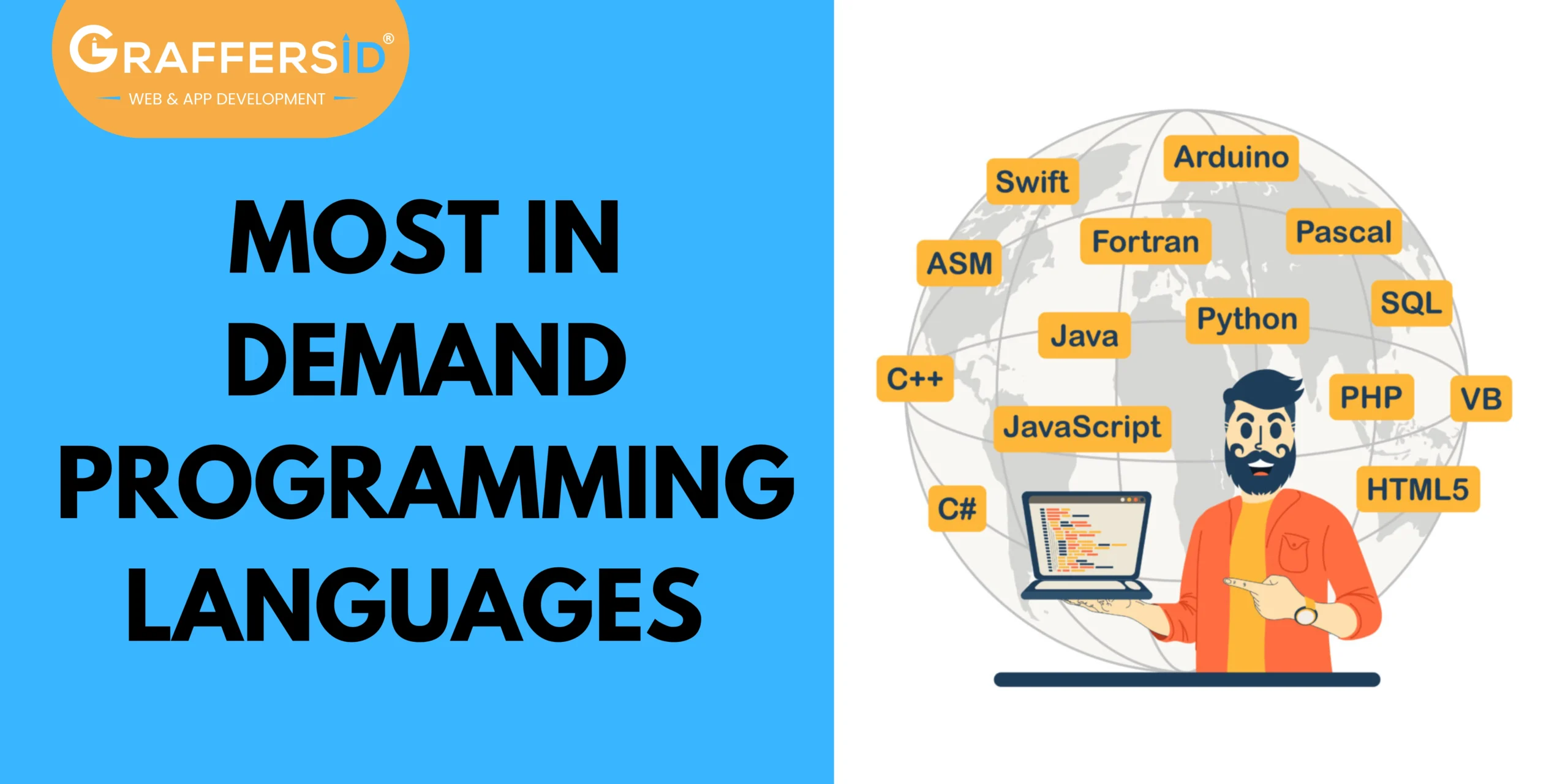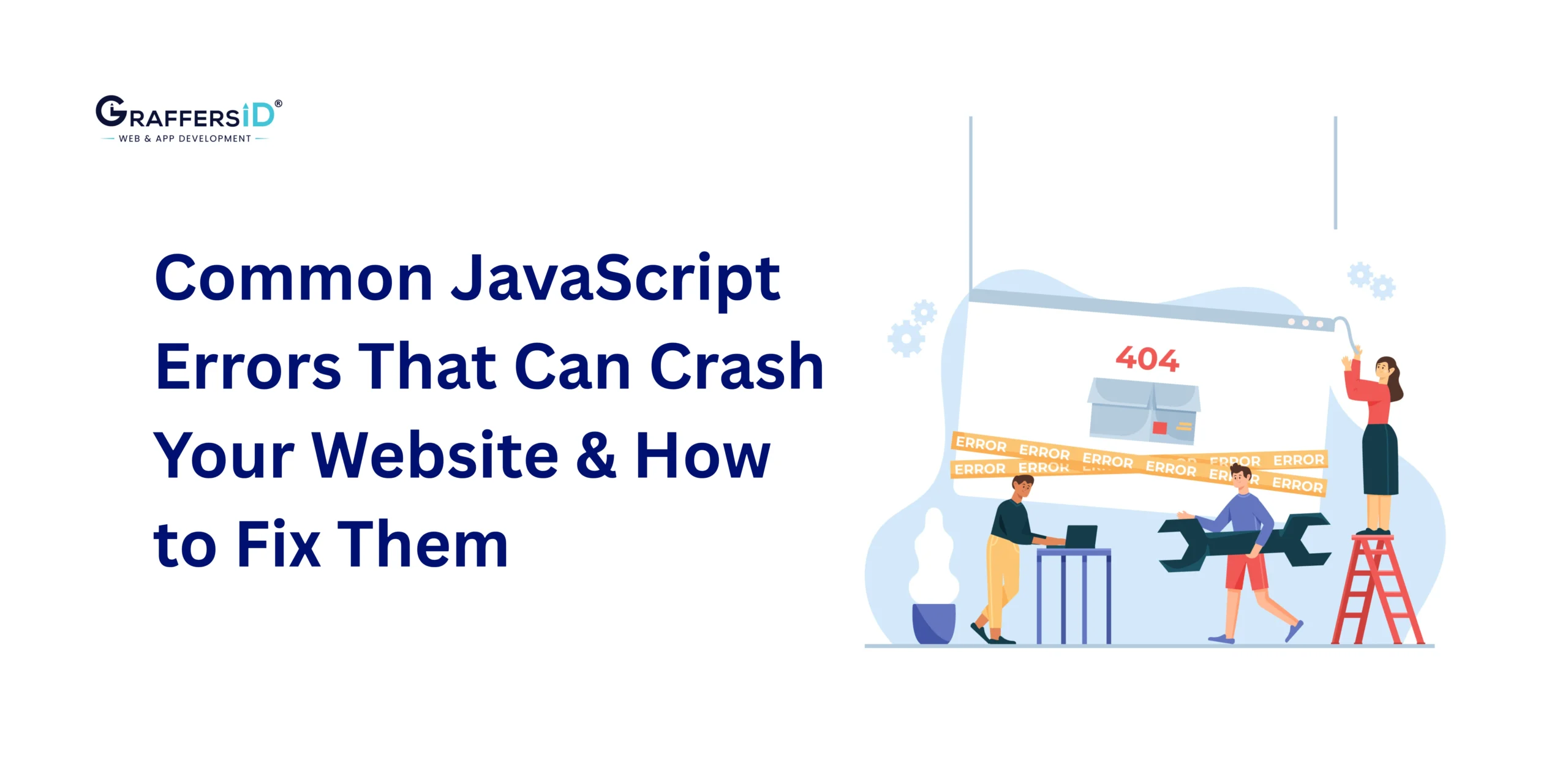The world of technology is booming and has become a place shrouded in mystery and exclusivity. The programmers are expected to have the edge over the coding abilities to stand out from the crowd. Most IT companies prefer developers who have a strong grasp and expertise in dealing with different programming languages. Hence, it becomes imperative to have a deep understanding of programming languages to thrive in big IT companies and it’s always wise to dive deeper into it. If you want to ace the coding industry, make sure you get your hands on the right language so that you don’t end up messing around your head over the wrong programming language. We’ve compiled the list of the most in demand programming languages that you can learn in 2025 without giving a second thought!
What is An in-demand Programming Language?
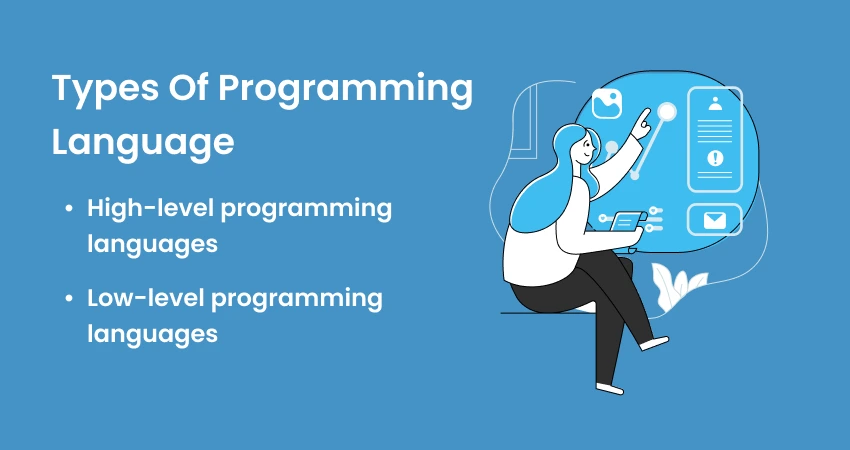
In a nutshell, programming languages involve a set of rules that enable the conversion of string values into different forms of visual programming languages, machine code, and graphical elements. It’s a way through which the developers or programmers communicate and give commands to computers. When it comes to the language in which a program is written, it’s done in Java, C++, C, and Python. The programming languages are based on coding syntax, which is used to develop software programs for specific task performance. There are two kinds of programming languages.
1. High-level Programming Languages
When it comes to high-level programming languages, you don’t have to get carried away by the word “high”. High-level programming stands for the language that is quite similar to the human language or that the syntax is similar to the English language, making it easy for humans to comprehend. Some of the most popular languages are Java, C++, C, and Python. You can make excellent mobile and web applications with high-level languages.
Read Also: Programming Languages that Will Trend in the Future
2. Low-level Programming Languages
Low-level languages can be assembly and machinery languages. Its applicability is to develop programs that are relatively specific to a computer’s hardware and architecture. Often, developers are reluctant to use machine languages as it gets a tad difficult to write programs. This paves the way for assembling languages. The assembler also converts it into machine language. Both languages can be used to develop device drivers and operating systems. It’s just not confined to these languages. According to the online history of the Encyclopedia of programming languages, the number of programming languages is quite speculative and is estimated to be around 9,000, which is astounding. However, the rising demand for programming languages is restricted to a few of them based on their popularity and usability.
How Did We Compile The List of Most in Demand Programming Languages?
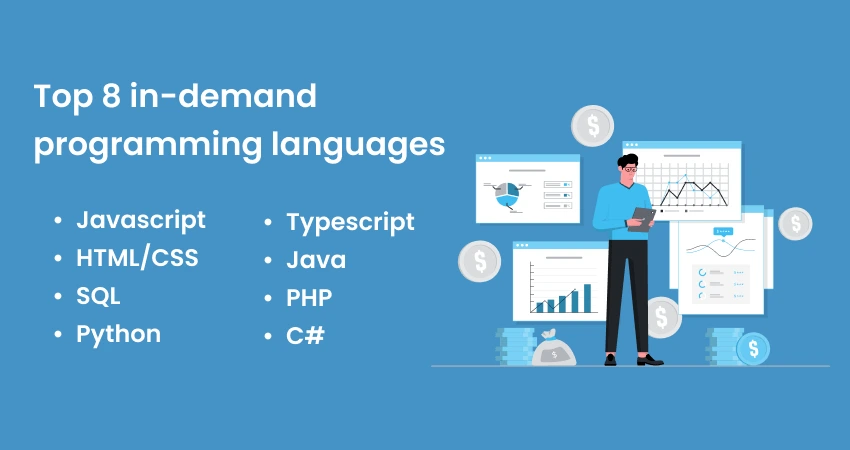
Considering Statista as an authentic source and a renowned company widely popular for having expertise in providing in-depth market and consumer data, we have gathered the list of top eight programming languages that are currently trending and have been preferred by organizations. The company claims to have more than 10,00,000 statistics on more than 80,000 topics across more than 180 industries. According to the latest data from Statista, JavaScript and HTML/CSS top the charts with more than 60% of developers fond of this language, while other languages such as HTML, CSS, SQL, Python, and Typescript are yet another bunch widely preferred languages.
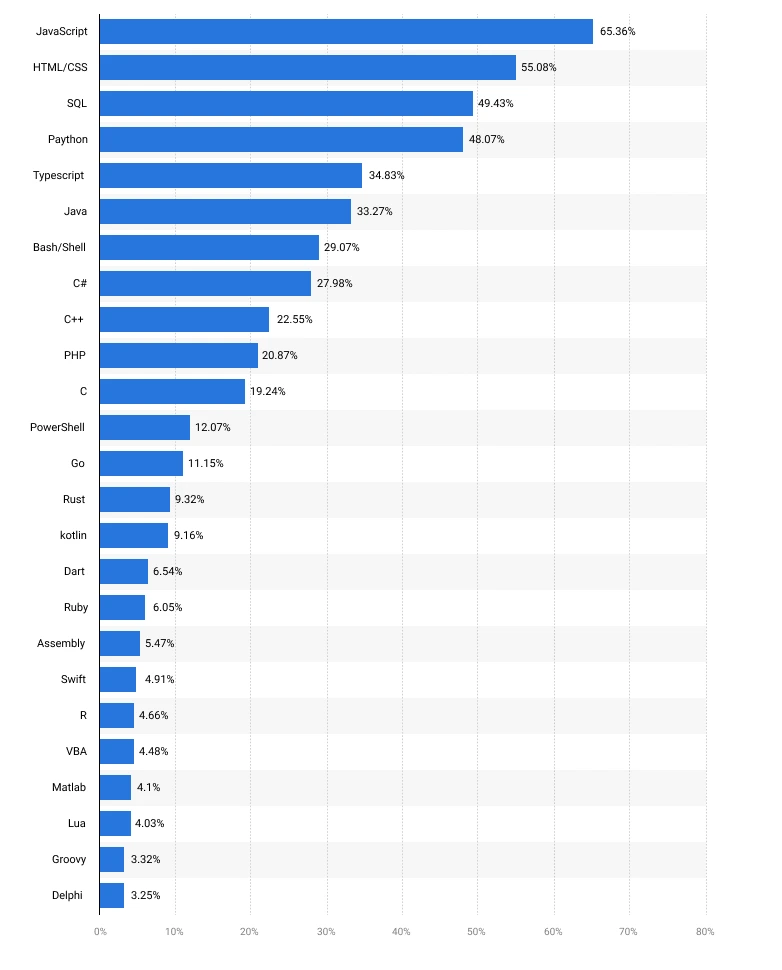
Most in demand programming languages:
1. Javascript
According to internet live stats, more than 2 billion websites have been developed with JavaScript, making it a massively popular programming language. If you are wondering how it is the best, try this once: don’t enable access to JavaScript on your web browser. You’ll notice that gradually your websites and applications will look monotonous due to a lack of web interaction. Javascript makes the website interactive and is simple to learn and use. Build applications for media and entertainment, healthcare, fintech, etc. The best part is that you don’t need any prior coding experience to learn it. It’s so easy to learn that you can easily learn it in a couple of days and kick off developing some websites. In addition, JavaScript is a notable component of the World Wide Web (www). Initially, the developers developed web browsers with JavaScript. With the advent of time, it’s also been used for non-browser applications and server-side deployments.
Want to know PHP vs Python: Which Language to Choose for Server-Side Development?
2. HTML/CSS
HTML, or HyperText Markup Language, is used to add content and structure text on the web. However, it’s not beneficial on the appearance front. With the help of CSS, cascading style sheets can be used with HTML to look after the font, color, and positions of elements. It might look like these languages are quite easy to use, but it’s just a facade as it’s difficult to develop applications and websites with them. Hence, developers prefer to specialize in different languages.
Popularity: More than 55% of developers prefer using this language for web development, making it a popular language.
3. SQL
SQL, or structured query language, is also referred to as the manipulation language. It’s a database management system that provides massive support for developers in retrieving and finding data where it can also be used to delete, update, and add records. It’s an excellent language for database and business management and works great for smaller databases and data management in relational database management systems. However, it’s not too good for larger databases.
Popularity: More than 49% of developers are drifting towards the usability of this language.
4. Python
Python is an open-source programming language that is used to develop 3D and 2D applications that involve Autodesk, Blender, Inkscape, and many more. Also, its usability extends to developing amazing video games. The readability of Python makes it stand out amongst other popular languages. Needless to mention, it’s backed by a large supportive community, ease of integration with web services, GUI-based desktop applications, user-friendly data structures, and an easy-to-learn language making it a go-to language for developers.
Popularity: Its usability is growing tremendously in both the business and technology industries.
Want to know Python vs Java: Which Language to Choose for your Application?
5. Typescript
Microsoft’s Typescript isn’t as old as other programming languages, as it was introduced in 2012 by Microsoft. It’s best suited for larger code bases. It can be used for both server-side and client-side development in JavaScript-based projects and works well for detecting errors and minimizing systematic issues.
Popularity: It’s rapidly gaining traction among programmers, particularly for large-scale programs.
6. Java
Wondering whether Java and JavaScript are the same? Java and JavaScript aren’t the same as Java is a more object-oriented language that doesn’t constitute classes and just defines behavior with its constructor function. Also, the JavaScript codes are written in text and can be interpreted by machines, whereas in Java, they require compilation. In addition, Java is used to develop web applications. It’s also been used for the backend of the most popular websites such as Amazon, Twitter, Google, and YouTube, and has been used for developing new applications such as hibernate, spring, and struts. The Java community is huge, which can be used to raise queries when learning Java.
Popularity: It’s always in high demand.
7. PHP
You’d be amazed to know that PHP has been used in the development of various websites such as Yahoo and Facebook and has been popular since 1990. With PHP, developers can easily create server-side scripts and command-line scripts. Just a basic knowledge of PHP will help with severed side scripts, and once you get expertise, you will also be able to make some incredible web applications.
Popularity: It’s a very active programming language that’s used for every other website development. Isn’t it great?
8. C#
C# is an object-oriented language. It is often used by developers for the.NET framework, Windows, Android, and iOS. It’s ideal for developing business applications as it’s interoperable with high scalability. Hence, it’s used for various business requirements.
Popularity: It’s not quite popular.
Programming Languages That Will Trend in 2025
Curious about what 2025 will bring to the programming world? You are at the right place. This article brings you the newest trends in the programming world.
So, without any wait, let’s have a look at the programming languages that will be trending in 2025 and the coming years.
1. Rust:
Rust is a multi-paradigm system programming language that enables everyone to build efficient and reliable software. Syntactically, Rust is similar to C++ however it provides better memory safety, along with maintaining high performance.
Rust has been successful in proving itself as a great language with a vibrant and active community. With Facebook building its biggest project ever, Libra, on Rust, we can clearly say that Rust has made off. And, this year Rust is sure to become mainstream officially.
Here are the operating system and related components that are programmed in Rust:
- Magic Pocket
- Stratis
- Railcar
- Firecracker
- Redox
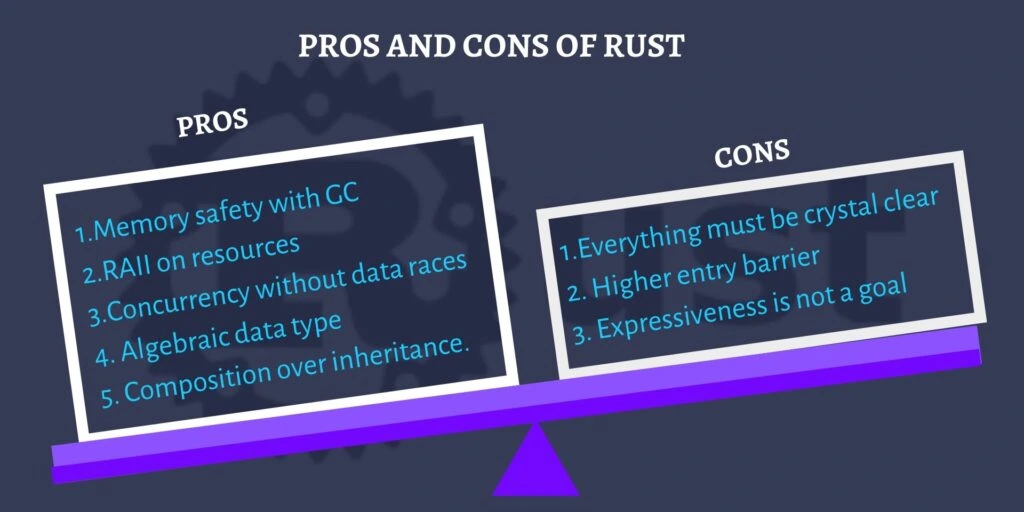
2. Python:
Python, released in 1991, was created by Guido van Rossum. It is one of the simplest languages, which is also high-level, user-friendly, easy-to-learn and fast to code.
According to a report from the IEEE Spectrum, Python reigns in the enterprise, web and embedded programming landscapes and is a king for a majority of ranking metrics. Python is a gold mine of opportunities that help developers to build virtual-based reality applications. This versatile language offers a seamless experience, aids in creating a wide range of applications using trending technologies like machine learning and artificial intelligence.
Few applications of Python include:
- Operating System Development
- Enterprise and business applications
- Web Framework and Application development
- Graphical User Interface Desktop Application Development
- For Prototyping
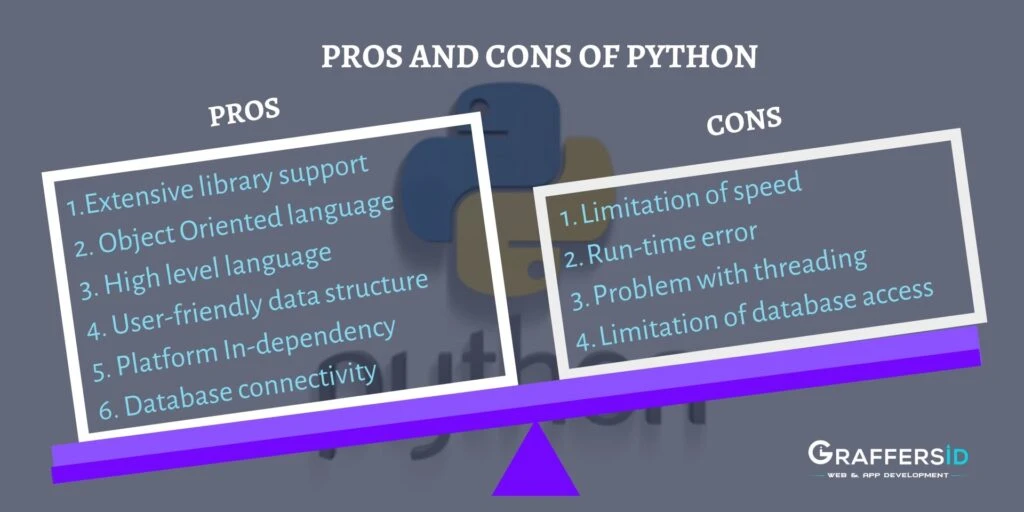
3. Java:
Java appeared in the industry in 1995, with a flexible option to run any browser window. It is a general-purpose programming language that is class-based, simultaneous, and object-oriented. Java was designed to allow application developers to write code once and run it anywhere without recompiling.
A recent survey conducted by the TIOBE stated that Java is a top programming language.
Java adapts to a dynamic environment, which means promotes dynamic allocation of memory, which increases the performance of the application and reduces memory. By using a bytecode, which can be easily translated into machine code, Java achieves high efficiency.
Java is mainly used in the development of:
- Embedded Systems and Web Applications
- Development of Application Servers and Web Servers
- Development of Enterprise Applications
- Development of Game Engine and Cloud Application
- Development of Distributed Application
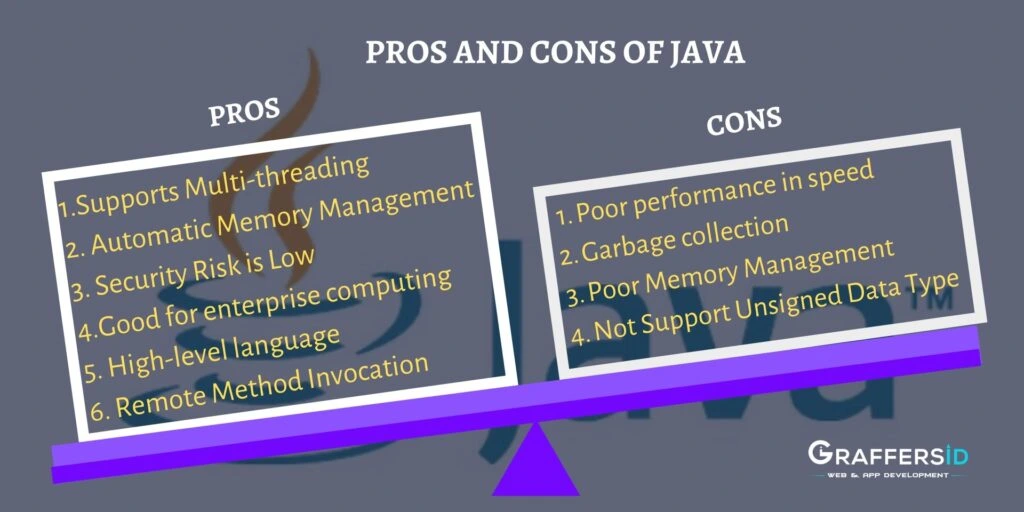
4. Swift:
Swift programming language was introduced in June 2014 by Apple Inc. It is multi-paradigm, general-purpose, iOS app development programming language for iOS, iPads, TVOS, macOS, Linus, watches and Z/OS.
This powerful and intuitive programming language is designed to work with Apple’s Cocoa framework. The primary aim of Swift was helping developers to build applications that can run efficiently on Apple devices. Swift removes all the unsafe codes and tracks all the errors which eliminate the incorrect application operation.
Here are a few applications of Swift:
- Mac OS Desktop Application
- Development of iOS Application

5. Javascript:
Appeared in December 1995, Javascript is a dynamic language, which is multi-paradigm and prototype-based. It supports imperative, object-oriented and declarative style by being the language of the web.
Javascript ensures no vulnerabilities and improves the possibility of data validation.The language is used for client-side programming and server-side. The language offers consistent updates, which help you meet market expectations.
Javascript is a widely-used programming language, which enables the developer to create high-level applications. It works well for the WEBVR platform that is involved in the production of a web-based application.
Here are some of the applications of the Javascript framework:
- Web Server Application Development
- Web Application Development
- Mobile App Development
- Smart Watch Application
- Game Development using HTML5
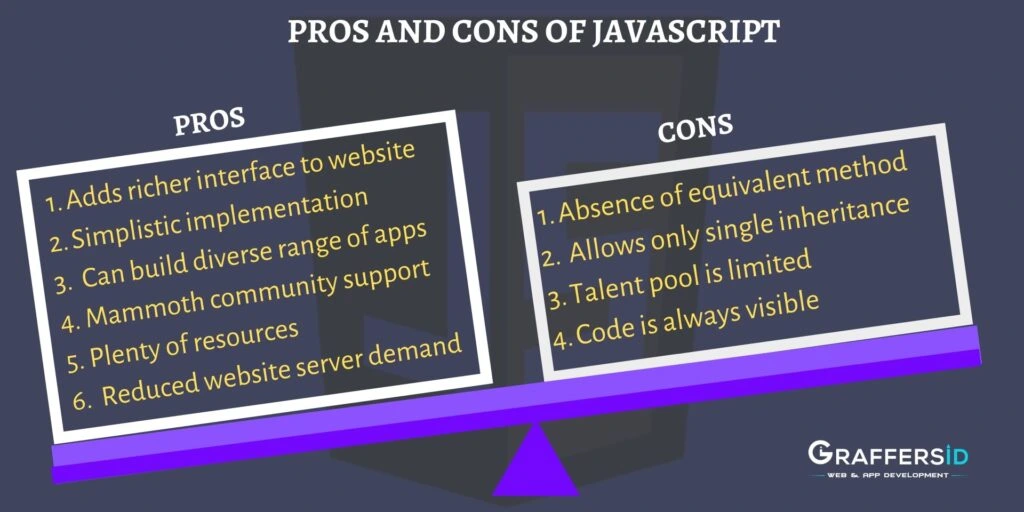
6. PHP:
PHP, also known as Hypertext Preprocessors, is a widely used language for web-based applications. It enables developers to create interactive and dynamic web pages that effectively work with the database. PHP, being easily embedded in HTML files and HTML codes, is also considered as a general-purpose programming language. If you wish to get development from the server-side, then this is the language you wish to choose.
Here are some of the applications of PHP:
- eCommerce Web Application
- Web Application Development
- Development of CMS
- Image Processing and Graphics Design
- Development of Data Representation System.
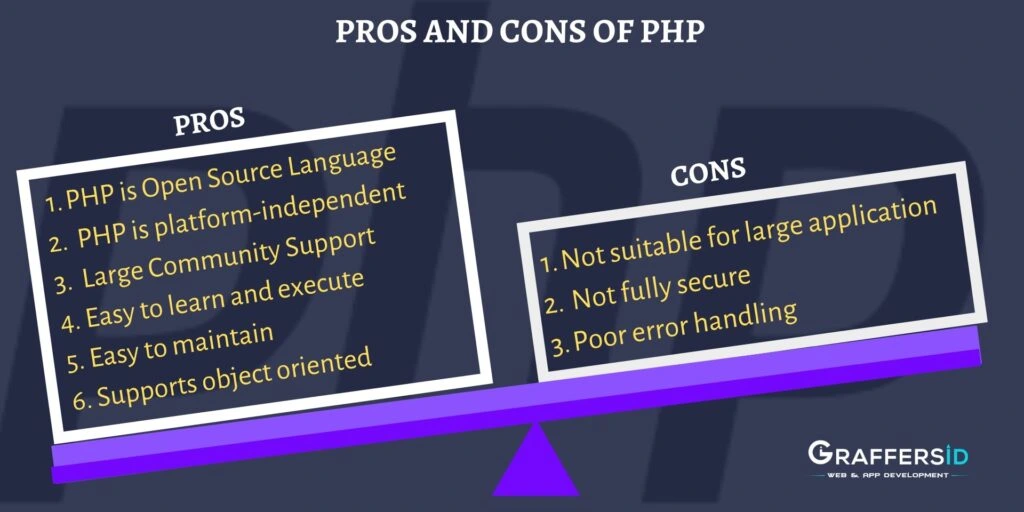
7. Ruby:
Ruby, designed by Yukihiro Matsumoto, is an object-oriented scripting programming language. Some of the top organizations like Groupon, Motorola, Scribd and Github are utilizing this general-purpose programming language.
This flexible language helps in redesigning existing parts and enables users to alter parts freely. It doesn’t need any variable declaration and generally prefers English keywords.
Ruby is mainly utilized for building:
- Web Application Development
- Server-Side Application Development
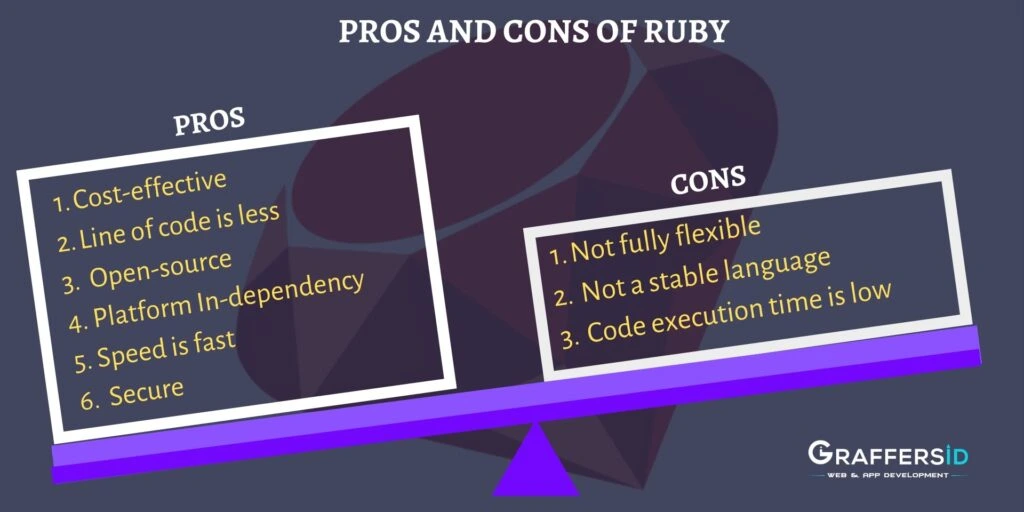
8. Kotlin:
Kotlin, designed by JetBrains, made its first appearance in 2011. It has gained momentum as an official language for Google and Android. It is popular as one of the best statistically typed, cross-platform, general-purpose programming language.
Kotlin is a distinct language that is expected to boost productivity in 2025. This modern language is beneficial for beginners and can be used as an entry point for web development. Utilizing the Kotlin multi-platform framework, one can select a shared codebase that runs two platforms at the same time.
Here are some of the applications of Kotlin:
- Android Application Development
- Native Application Development.
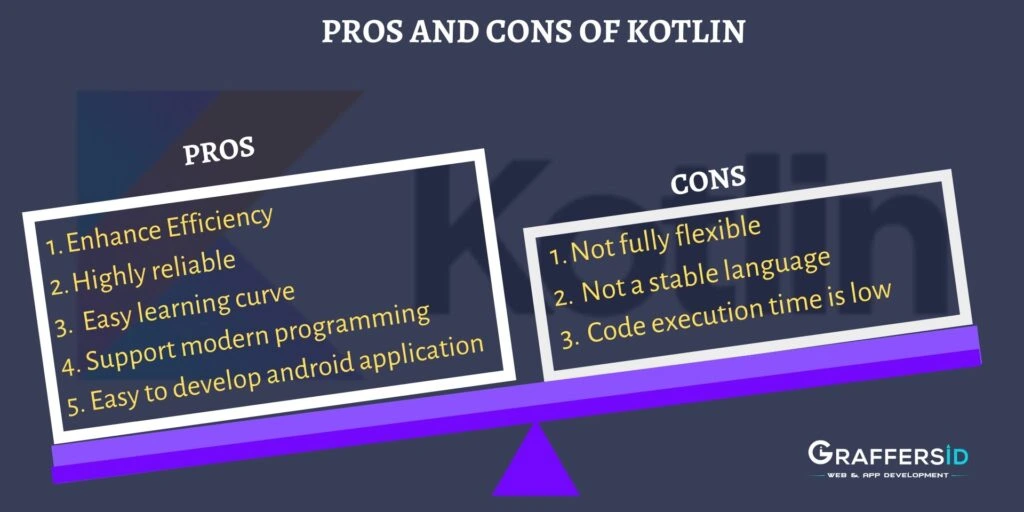
9. Go (Golang):
Go, or Golang, gains momentum in 2025 for its efficiency in building scalable and concurrent systems. With its simple syntax, built-in concurrency mechanisms, and fast compilation times, Go is a preferred choice for developing microservices, cloud-native applications, and distributed systems. Its reliability, performance, and support from tech giants like Google fuel its demand among developers tackling complex infrastructure challenges.
10. Dart:
Dart, known for its role in Flutter, gains prominence in 2025 for cross-platform app development. Flutter’s popularity soars as a framework for building natively compiled applications for mobile, web, and desktop from a single codebase. Dart’s simplicity, fast development cycles, and hot reload feature make it a preferred choice for developers aiming to deliver consistent and high-performance experiences across platforms.
11. Julia:
Julia emerges as a rising star in scientific computing and numerical analysis in 2025. Known for its speed, high-level syntax, and strong support for mathematical and statistical operations, Julia attracts researchers, engineers, and scientists tackling complex computational problems. Its ability to seamlessly integrate with existing languages and libraries makes it a compelling option for high-performance computing applications.
Comparing languages and choosing the right one for your project is an intimidating job. Figuring out which language is best for you to depend on the requirements and the futuristic approach that you wish to follow in 2025. Considering the rapid growth in the tech industry, it would not be wrong to say all the languages are essential to building a next-generation app.
Conclusion
You must have a decent idea about these programming languages and why they have made developers go head over heels. Make sure you select the right language for you based on your interest, and its scope in the future. Contact our experts or visit our website and choose from a global talent pool.
